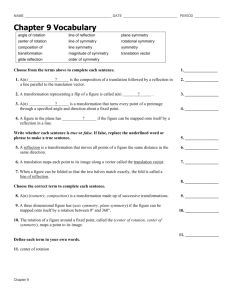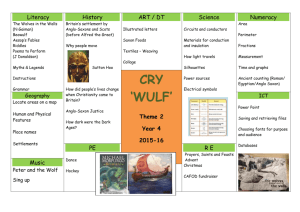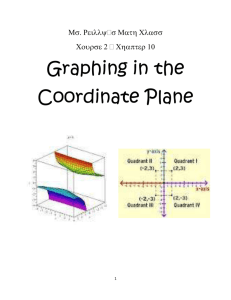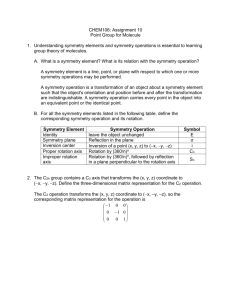Plane Figure Symmetry
advertisement
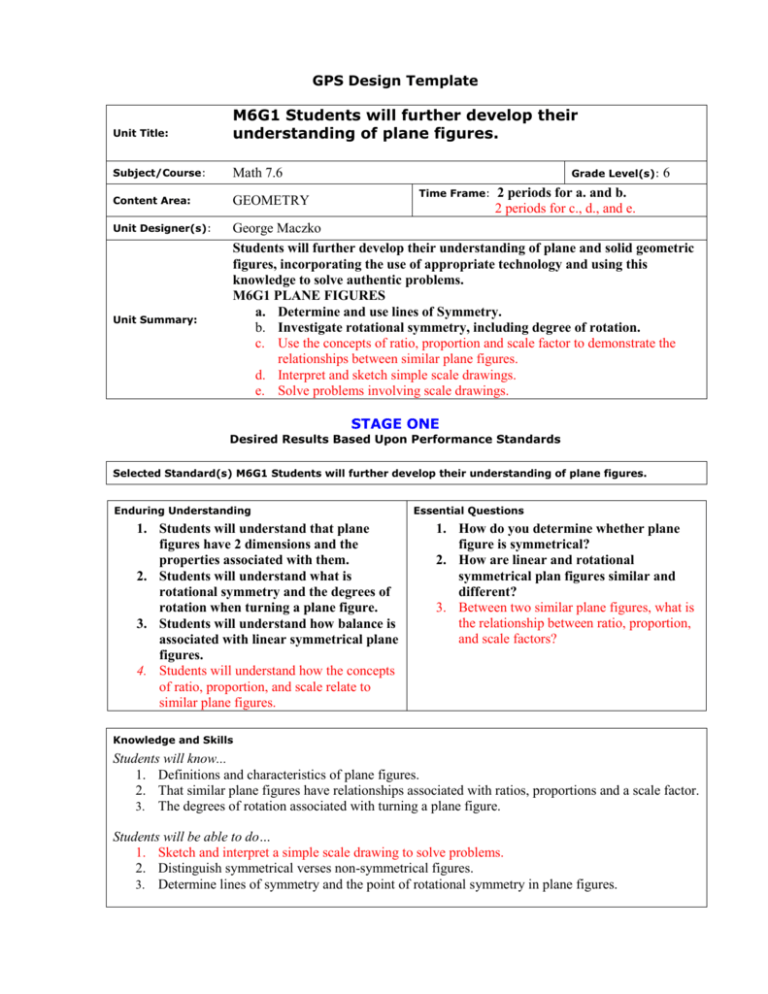
GPS Design Template Unit Title: M6G1 Students will further develop their understanding of plane figures. Subject/Course: Math 7.6 Content Area: GEOMETRY Unit Designer(s): George Maczko Students will further develop their understanding of plane and solid geometric figures, incorporating the use of appropriate technology and using this knowledge to solve authentic problems. M6G1 PLANE FIGURES a. Determine and use lines of Symmetry. b. Investigate rotational symmetry, including degree of rotation. c. Use the concepts of ratio, proportion and scale factor to demonstrate the relationships between similar plane figures. d. Interpret and sketch simple scale drawings. e. Solve problems involving scale drawings. Unit Summary: Grade Level(s): Time Frame: 6 2 periods for a. and b. 2 periods for c., d., and e. STAGE ONE Desired Results Based Upon Performance Standards Selected Standard(s) M6G1 Students will further develop their understanding of plane figures. Enduring Understanding 1. Students will understand that plane figures have 2 dimensions and the properties associated with them. 2. Students will understand what is rotational symmetry and the degrees of rotation when turning a plane figure. 3. Students will understand how balance is associated with linear symmetrical plane figures. 4. Students will understand how the concepts of ratio, proportion, and scale relate to similar plane figures. Essential Questions 1. How do you determine whether plane figure is symmetrical? 2. How are linear and rotational symmetrical plan figures similar and different? 3. Between two similar plane figures, what is the relationship between ratio, proportion, and scale factors? Knowledge and Skills Students will know... 1. Definitions and characteristics of plane figures. 2. That similar plane figures have relationships associated with ratios, proportions and a scale factor. 3. The degrees of rotation associated with turning a plane figure. Students will be able to do… 1. Sketch and interpret a simple scale drawing to solve problems. 2. Distinguish symmetrical verses non-symmetrical figures. 3. Determine lines of symmetry and the point of rotational symmetry in plane figures. STAGE TWO Evidence of Student Learning Based Upon Data ∆ Assessment through Work Product SUMMATIVE ASSESSMENT: SUMMATIVE FEEDBACK: What cumulating performance task or test will be used for students to demostrate mastery of the content material? 1. Students will take a Saxon Generated quiz or Class. 2. The Class will create a Venn diagram or Double Bubble map to compare and contrast Linear and Rotational Symmetry. What will be the instrument for giving feedback to students upon their performance and what criteria will be used? How will the feedback promote continued learning after the unit ends? 1. Mastery on Saxon generated assessment is achieved with a score greater than 79%. Any score below 80% will result in the student’s need to write an essay using the class’s graphic organizer that compares and contrasts Rotational and Linear Symmetry. Afterwards, the student will retake the written assessment. 2. No grade will be given; only comments are recorded in the student’s mark book. FORMATIVE ASSESSMENTS: FORMATIVE FEEDBACK: What performance task(s) or quiz(es) will be used for students to monitor their progress and for the teacher to redirect the learning process? 1. Students will complete 20 problems from lessons 180, 109, 110. 2. Students’ journal writings. 3. Students in groups will submit word maps. What will be the instrument for giving feedback to students upon their performance and what criteria will be used? How will students will able to use the feedback to increase their performance on future assessments? 1. Students will work in collaborative pairs on the problem set and will correct their homework as a group. A numeric score is given after corrections are made and the homework grid is submitted. 2. A writing rubric will be used to score their journal writing or students may present their group’s activity summary, using a presentation rubric. Comments are recorded in the student’s mark book. 3. After class discussion, each group will submit their word maps for review and comments to be added. Comments may be recorded in the student’s mark book. ∆ Assessment through Observation ∆ Assessment through Conversation How will the teacher observations be focused, recorded, and organized in order that they may serve as evidence of student learning? 1. Students identify the lines of symmetry for all letters of the alphabet. 2. Students create snowflakes. 3. Students perform Geometric Simon Says, including degrees of rotation. How will self-assessment and reflective dialog with others be used as evidence of student learning? 1. Students will discuss within their groups to determine the lines of symmetry for all letters of the alphabet. Answer sheets may be corrected by the students when reviewed as a group and/or collected. 2. Students will describe to teacher how symmetry applies to snowflakes. STAGE THREE Learning Experiences Learning Activities PROCEDURE: 1. Teacher defines transformations on white board and identifies Simon Says gestures for Flip (reflection), Slide (translation), and Turn (rotation). Class discusses previous Simon Says Geometric Gestures, including degrees for angles (Acute, RIGHT, Obtuse) to be used later with rotational symmetry. Geometric Simon Says is used to bring students back on task or as warm up throughout the Geometry Lessons. 2. Teacher led PowerPoint presentation describes symmetry, asking students to use a pointer to cast a shadow on the line of symmetry on the images displayed. 3. Box Top Activities. (Using the tops of paper boxes to organize different activities, the teacher allows groups or pairs of students to perform a task for 10 minutes before switching to another “box top activity” containing a related learning activity. a. Learning activity 1: Completing the activities and recording in their journals, as a group, an activity summary to share with the class, students will access the following websites: distinguishing linear vs. rotational symmetry on http://www.bbc.co.uk/schools/gcsebitesize/maths/shape/sym metryrev1, and accessing the Kaleidoscopes and/or Snowflakes projects on www.Adrianbruce.com/symmetry. b. Learning Activity 2: Students are given a set of alphabetic cards and a mirror. Students must categorize the letters according to their associated number of lines of linear symmetry. Their data should be collected, recorded, and shared with the class at the end of the lesson. c. Learning activity 3: Students are given instructions on how to fold a paper into 2, 4, and 6 equal segments. Identifying the point of rotational symmetry, students cut the paper to create shapes, including a snowflake (H2O) six equal sides. 4. Students are to review Saxon Lessons 108 Transformations, 109 Corresponding Parts Similar Triangles, and 110 Symmetry. 5. Working in Collaborative-Pairs, students are assigned 20 problems for homework from the three lessons. 6. Homework is reviewed day 2, along with all word maps and journal entries. Students present the information they collected from the learning activities. A quiz may be given if students have a clear understanding of the material or may be postponed until after the concepts of ratio, proportion and scale factors are demonstrated between similar plane figures (M6G1c., d., e.) 7. Students share their group’s findings, ask questions and instructed to create a word map for the following terms: Symmetry, Similar, Congruent, Reflection, Translation, and Rotation. 8. A Saxon generated written quiz or test is given, reviewed, and corrected. MATERIALS & RESOURCES: White board and markers, LCD projector for Symmetry PowerPoint presentation, pointer or meter stick, 2 PCs with internet access to 2 to 3 website tasks, lettered cards, mirrors, paper, scissors, Saxon 7.6 textbook and homework grid sheet, Saxon generated assessment. Comments Previous terms included in Geometric Simon Says are from Saxon Lesson 68, including Lines. Saxon Lessons 107 and 120 discusses the classification of Angles and Triangles, respectively. These lessons should be reviewed and discussed prior to this unit and covering Saxon Lessons 108, 108, and 110. M6G1 c., d., e., in red ink, are not part of this unit plan, however, many of the concepts should be applied and covered immediately prior to or at the conclusion of this lesson. M6G2 Solid Figures is the second and final geometry concept to be covered in sixth grade. Attached Files FILE NAME WITH EXTENSION: FILE DESCRIPTION: Symmetry Saxon Problem Set Grid SYMMETRY.WS GPS Mark Book Symmetry PowerPoint presentation. Homework Grid for 20 Problems Saxon Generated written symmetry evaluation Excel Spreadsheet for marking whether students exceed, met, or has not yet met the GPS standard and a plan to achieve their highest level. Unit Design template GPS Design Template Credits and Sources Lynanne Betz, math teacher at Awtrey Middle School, Kennesaw, GA, LynanneBetz@cobbk12.org http://www.bbc.co.uk/schools/gcsebitesize/maths/shape/symmetryrev1.shtml www.Adrianbruce.com/symmetry Saxon 7.6 An Incremental Development, third edition, Stephan Hake and John Saxon, Saxon Publishers, Inc., 2002


